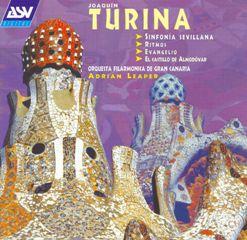Joaquín Turina – Sinfonia Sevillana, Ritmos, Evangelio, El Castillo de Almodóvar (1999)
Joaquín Turina – Sinfonia Sevillana, Ritmos, Evangelio, El Castillo de Almodóvar (1999)

Sinfonia Sevillana, Op. 23 1 First Movement: Panorama 8:32 2 Second Movement: Por el rio Guadalquivir 7:27 3 Third Movement: Fiesta en San Juan de Aznalfarache 8:00 4 Evangelio, Op. 12 13:00 El Castillo De Almodóvar 5 First Movement: Silueta nocturna 5:54 6 Second Movement: Evocación medieval 4:02 7 Third Movement: A plena luz 5:06 8 Ritmos (Fantasia coreogafica), Op. 43 15:10 Catrin Mair Williams (harp) Orquesta Filarmónica De Gran Canaria Adrian Leaper - conductor
Joaquin Turina was a Sevillano - no wonder that he produced a Sinfonia Sevillana. He was a friend of de Falla and a pupil of Moskowski and of D'Indy and had studied in Paris. His most famous works are the Danzas Fantásticas, the Oración del Torero and the Rapsodia Sinfónica. The latter two can also be heard on another ASV (CD DCA775). A recent and admirable Chandos CD (Record of the Month) of orchestral pieces overlaps with the present ASV in the case of two works: Sinfonia Sevillana and Ritmos. Leaper takes a sensitively voluptuous way through the Sinfonia Sevillana and the ASV recording team more than meet Leaper half-way. There is some silky quiet playing here alongside the euphoria of the opening Panorama and closing Fiesta. His early Evangelio is suitably placid and serene - even if it was written during the Great War. While going light on the caramel it has a sweet and dignified disposition. El Castillo de Almodovar is in three movements. Again this is a sumptuously melodic work with no shortfall of local colour even if it does avoid the castanets. Rather like the works of the 1930s by Ernesto Halffter, Turina takes a leaf from Ravel's book when it comes to delicacy and atmosphere. The last movement ('in full light') meets a modicum of striding confidence with lyrical intricacy. We also get to hear Catrin Mair Williams's harp to good and understated effect. I wondered if Ritmos (Fantasia coreografica) might be drier but it has plenty of rhapsodic colour and snap as well as seductive romance. If you enjoy de Falla you are very likely to want to know Turina; well worth exploring beyond the headline pieces. He may not have quite the clatter and bite of de Falla but he is a poet of atmosphere and no mean celebrant when it comes to Spanish dance figures. ---Rob Barnett, musicweb-international.com
download (mp3 @320 kbs):
yandex mediafire ulozto cloudmailru gett








